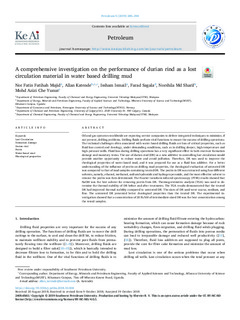| dc.description.abstract | Oil and gas operators worldwide are expecting service companies to deliver integrated techniques to minimize, if not prevent, drilling problems. Drilling fluids perform vital functions to ensure the success of drilling operations. The technical challenges often associated with water-based drilling fluids are loss of critical properties, such as fluid loss control and rheology, under demanding conditions, such as in drilling deeper, high-temperature and high-pressure wells. Fluid loss during drilling operations has a very significant effect in both reservoir formation damage and monetary terms. The use of durian rind (DR) as a new additive in controlling lost circulation would provide another opportunity to reduce waste and avoid pollution. Therefore, DR was used to improve the rheological properties of water-based mud, and it was prepared for use as a fluid loss additive. For a better understanding of the influence of pectin on drilling mud properties, the rheological evaluation of untreated DR was compared to that of mud samples containing treated DR. The pectin in DR was extracted using four different solvents, namely, ethanol, methanol, sodium hydroxide and hydrogen peroxide, and the most effective solvent to remove the pectin was then determined. The Fourier transform infrared spectroscopy (FTIR) results showed that NaOH was the best solvent for removing pectin from DR. Thermogravimetric analysis (TGA) was used to determine the thermal stability of DR before and after treatments. The TGA results demonstrated that the treated DR had improved thermal stability compared to untreated DR. The sizes of DR used were coarse, medium, and fine. The untreated DR presented better rheological properties than the treated DR. The experimental investigation showed that a concentration of 20 lb/bbl of intermediate-sized DR was the best concentration among the tested samples. | nb_NO |

